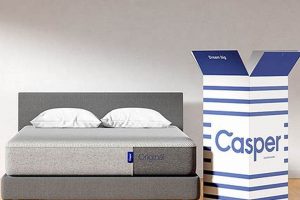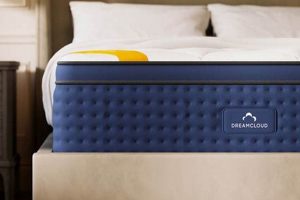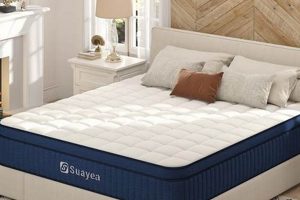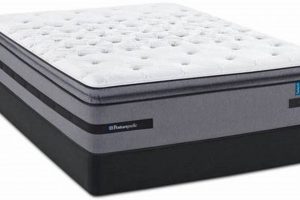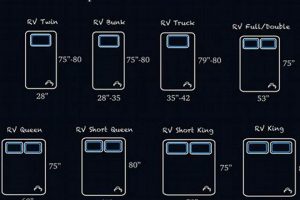The specifications 72×80 define a rectangular sleeping surface intended for recreational vehicles. This size, expressed in inches, describes the width and length, respectively, of the bedding. Its use is primarily within the RV industry, offering a larger sleep area than standard RV mattress sizes, akin to a residential king but adapted for the spatial constraints commonly found within mobile living spaces.
Utilizing a sleeping surface of this size within an RV offers enhanced comfort for occupants, providing more room for movement and a less restrictive rest environment, particularly beneficial for couples. Historically, RV mattresses were often smaller and less comfortable, but the growing demand for comfort and extended travel durations has led to increased availability and popularity of larger, more accommodating sizes. This shift reflects a greater emphasis on residential-style amenities within the RV lifestyle.
The subsequent discussion will explore the construction materials commonly used in manufacturing these specific mattresses, the different comfort levels available, and considerations for selecting the most suitable option for individual needs and RV compatibility.
Selection Guidance for Recreational Vehicle King Mattresses
The following guidance assists in choosing a suitable recreational vehicle mattress, specifically those conforming to the 72×80 inch dimension.
Tip 1: Measure the Available Space. Prior to any purchase, accurately measure the sleeping platform within the RV. Variations in construction can lead to discrepancies, and ensuring the mattress fits without excessive compression or overhang is essential.
Tip 2: Consider Mattress Thickness. RVs often have height restrictions. A thicker mattress may compromise headroom or interfere with overhead storage compartments. Assess vertical space limitations before selecting a mattress with significant depth.
Tip 3: Evaluate Foam Density. Higher-density foams generally offer greater support and durability. Individuals with higher body weights or those requiring enhanced spinal alignment should prioritize mattresses with denser foam cores.
Tip 4: Assess Ventilation Properties. RVs are prone to temperature fluctuations and humidity. Mattresses with breathable covers and open-cell foam structures promote air circulation, minimizing moisture retention and improving sleep comfort.
Tip 5: Research Fire Retardancy Standards. RV mattresses should comply with applicable fire safety regulations. Verify that the selected mattress meets or exceeds established flammability standards for recreational vehicles.
Tip 6: Inquire About Warranty Coverage. A comprehensive warranty demonstrates the manufacturer’s confidence in the product’s longevity and provides recourse in the event of premature degradation or manufacturing defects. Scrutinize the warranty terms and conditions.
Tip 7: Review Compression and Roll Pack Considerations. Some mattresses are compressed and roll-packed for easier shipping and installation into the confined spaces of an RV. Understand the unpacking and expansion time required before use.
Adherence to these guidelines contributes to a more informed purchasing decision, optimizing comfort, longevity, and safety within the recreational vehicle sleeping environment.
The subsequent section addresses the common materials used in the construction of these mattresses and their relative merits.
1. Dimensional Accuracy
Dimensional accuracy is critical when selecting a recreational vehicle king mattress of the specified size. The stated measurements (72×80 inches) represent the intended outer dimensions. Deviation from these measurements, even by a small margin, can result in installation difficulties, reduced comfort, and potential damage to the mattress or the RV’s bed frame. For instance, a mattress slightly larger than specified may require forced compression, leading to uneven wear and reduced lifespan. Conversely, a mattress that is too small will create gaps, diminishing support and increasing the risk of injury during sleep.
The precision in manufacturing these mattresses directly impacts customer satisfaction and the product’s functionality. Consider an instance where a manufacturer consistently produces mattresses with a width of 71.5 inches instead of the stated 72 inches. This seemingly minor difference accumulates over the length of the mattress, leading to a noticeable gap on either side when placed on a standard RV king frame. This gap can cause discomfort, allow items to fall between the mattress and frame, and potentially damage the surrounding structure over time. Quality control measures during production are therefore paramount to ensure adherence to the specified dimensions.
In conclusion, dimensional accuracy is not merely a technical specification but a fundamental requirement for the usability and longevity of a recreational vehicle king mattress. Failing to maintain precise measurements negates the intended benefits of this size and can lead to a cascade of negative consequences for the consumer. Adherence to strict dimensional standards ensures proper fit, maximizes comfort, and contributes to the overall safety and functionality of the RV sleeping environment.
2. Foam Density Options
Foam density in recreational vehicle king mattresses directly influences support, durability, and overall comfort. The choice of density affects the suitability of the mattress for various individuals and usage scenarios. Higher density foams generally offer greater resistance to compression and longer lifespans, while lower densities may provide a softer initial feel but can degrade more rapidly under consistent use within the confined space of an RV.
- Support and Spinal Alignment
Higher density foams offer increased resistance to compression, leading to improved spinal alignment, particularly beneficial for individuals with back pain or those who require firmer support. For instance, a high-density memory foam core in a 72×80 RV king mattress can minimize pressure points and maintain proper spinal curvature throughout the night. Conversely, low-density foams may compress excessively, causing spinal misalignment and discomfort. The selection should correlate with individual physical needs and preferred sleep position.
- Durability and Longevity
Foam density directly correlates with mattress durability. Higher-density foams possess a greater capacity to withstand repeated compression cycles without significant degradation. A high-density polyurethane foam base, for example, will maintain its structural integrity for a longer duration compared to a low-density counterpart. This translates to a longer lifespan for the mattress, making it a more economical choice in the long term, particularly for full-time RVers or frequent travele
rs who subject the mattress to consistent use. The investment in a higher density option reduces the need for premature replacement. - Weight Considerations
While higher density foams offer enhanced support and durability, they also contribute to increased mattress weight. This is a crucial consideration for RV applications, where weight management is essential for fuel efficiency and overall vehicle performance. A heavier 72×80 RV king mattress can add significant weight to the RV, potentially exceeding weight limits or impacting handling characteristics. Balancing the desire for higher density with the need to minimize weight is a critical factor in selecting the appropriate foam density for an RV mattress.
- Temperature Sensitivity
Foam density can influence the temperature sensitivity of the mattress. Denser foams tend to retain more heat compared to less dense foams. This can be a disadvantage in warmer climates or for individuals who tend to sleep hot. A high-density memory foam mattress, for example, may become uncomfortably warm during the night. Conversely, lower density foams and open-cell foam structures promote better airflow and heat dissipation, contributing to a cooler and more comfortable sleeping environment. The local climate and personal preferences should inform the choice of foam density in relation to temperature regulation.
In summary, selecting the appropriate foam density for a 72×80 RV king mattress involves a trade-off between support, durability, weight, and temperature sensitivity. No single density is universally optimal; the ideal choice depends on individual needs, usage patterns, and the specific environmental conditions within the recreational vehicle. A thorough assessment of these factors ensures that the selected mattress provides the optimal balance of comfort, support, and longevity within the constraints of the RV environment.
3. Weight Considerations
The specification of a recreational vehicle king mattress as 72×80 inches introduces significant weight considerations. A larger sleeping surface inherently requires more material, directly impacting the overall mass of the mattress. This weight becomes a critical factor in RV applications due to its influence on fuel efficiency, handling characteristics, and adherence to the vehicle’s maximum weight capacity. Exceeding the RV’s weight limits can compromise safety and structural integrity. For example, a heavy mattress combined with other added weight may lead to reduced braking effectiveness or increased tire wear. The selection of lighter materials, such as specific foam types or construction methods, becomes paramount in mitigating these risks.
The choice of materials, such as high-density memory foam versus latex or lighter polyurethane blends, demonstrates the practical implications of weight management. While high-density memory foam may offer superior comfort and support, it also contributes significantly to the mattress’s overall weight. Conversely, latex provides a balance of comfort and support with a potentially lower weight profile, while lighter polyurethane blends may offer the lowest weight but potentially compromise durability. Therefore, manufacturers and consumers must carefully evaluate the trade-offs between comfort, durability, and weight when selecting a recreational vehicle king mattress. Furthermore, the integration of lightweight support structures, such as specialized coil systems or reinforced edges, plays a crucial role in maintaining structural integrity without adding excessive weight.
In summary, the weight considerations associated with a 72×80 RV king mattress are integral to the safe and efficient operation of the recreational vehicle. The cumulative effect of all added weight, including the mattress, necessitates a thorough understanding of material properties and their impact on the vehicle’s performance. Prioritizing lightweight materials and construction techniques is essential for optimizing fuel economy, maintaining safe handling characteristics, and preventing structural damage. Therefore, weight management remains a critical aspect in the design, selection, and utilization of recreational vehicle mattresses.
4. Material Breathability
Material breathability exerts a significant influence on the comfort and hygiene of a 72×80 recreational vehicle king mattress. Within the confined space of an RV, temperature fluctuations and limited ventilation can create an environment conducive to moisture accumulation. Mattress materials with inadequate breathability exacerbate this issue, trapping moisture and body heat. This, in turn, promotes the growth of mold, mildew, and bacteria, leading to unpleasant odors, allergic reactions, and potential health hazards. For example, a mattress constructed with closed-cell foam and a non-breathable cover will restrict airflow, causing occupants to experience discomfort due to overheating and increased perspiration during sleep. The material’s capacity to dissipate heat and moisture directly affects the quality of rest and the long-term maintenance of the mattress.
The selection of breathable materials mitigates these adverse effects. Open-cell foam structures, such as latex or certain types of memory foam infused with cooling gels, facilitate air circulation within the mattress core. Similarly, covers made from natural fibers like cotton, bamboo, or Tencel offer enhanced breathability compared to synthetic materials like polyester or vinyl. These materials allow moisture to evaporate more readily, reducing the risk of microbial growth and maintaining a cooler, drier sleep surface. An RV mattress utilizing open-cell memory foam and a bamboo cover, for instance, will demonstrate superior breathability compared to a traditional memory foam mattress with a polyester cover, resulting in a more comfortable and hygienic sleep environment, especially in humid climates or during periods of high occupancy.
In conclusion, material breathability is a crucial consideration in the design and selection of a 72×80 recreational vehicle king mattress. Its influence extends beyond mere comfort, impacting hygiene, health, and the longevity of the mattress itself. Prioritizing breathable materials in both the core and cover of the mattress is essential for mitigating moisture accumulation, regulating temperature, and ensuring a consistently clean and comfortable sleep environment within the challenging confines of a recreational vehicle. Failure to address breathability can result in a compromised sleeping experience and potential health risks for occupants.
5. Vehicle Compatibility
Vehicle compatibility represents a critical factor in the successful integration of a 72×80 recreational vehicle king mattress. This encompasses not only the physical fit within the designated sleeping area but also broader considerations related to weight distribution, access limitations, and adherence to safety standards. Optimizing compatibility ensures both comfort and the safe operation of the recreational vehicle.
- Dimensional Constraints and Physical Fit
The RV’s sleeping platform must accommodate the precise 72×80 inch dimensions. Variations in constr
uction necessitate accurate measurement prior to purchase. Obstructions such as wheel wells, cabinetry, or slide-out mechanisms can impede proper installation. For example, a fractionally undersized space may require compressing the mattress, leading to uneven wear, while an obstruction could prevent the mattress from lying flat. Dimensional incompatibility compromises comfort and potentially damages the mattress or surrounding structures. - Weight Distribution and Load Capacity
The combined weight of the mattress and occupants must remain within the RV’s specified load capacity. Exceeding this limit compromises handling, braking performance, and tire integrity. A heavy mattress concentrated in one area can negatively impact weight distribution, particularly in smaller RVs. Careful consideration of the mattress’s weight, in conjunction with other onboard loads, is essential to maintain safe operating conditions. Vehicle manufacturers publish guidelines regarding maximum load, which must be adhered to.
- Access and Maneuverability during Installation
The confined spaces within RVs present challenges during mattress installation. Narrow doorways, tight corners, and limited headroom can hinder maneuverability. Some mattresses are compressed and rolled for easier transport, but even these require careful handling. Ensuring sufficient clearance and employing appropriate lifting techniques minimizes the risk of damage to the mattress or the RV’s interior during installation. Pre-planning the installation path and removing any potential obstructions are essential steps.
- Compliance with Safety Regulations
RV mattresses must adhere to established flammability standards and safety regulations. Verification that the mattress meets or exceeds these standards is critical to protect occupants in the event of a fire. Additionally, some RV configurations may necessitate specific mattress features, such as reinforced edges or non-slip surfaces, to prevent shifting during transit. Confirmation of regulatory compliance ensures the safety and well-being of the vehicle’s occupants.
These facets of vehicle compatibility underscore the importance of meticulous planning and measurement prior to selecting a 72×80 RV king mattress. Overlooking these considerations can result in discomfort, safety hazards, and potential damage to the vehicle. A comprehensive assessment of dimensional constraints, weight distribution, access limitations, and safety regulations is crucial for ensuring a successful and safe integration of the mattress into the recreational vehicle.
Frequently Asked Questions
The following questions address common inquiries and concerns regarding recreational vehicle king mattresses conforming to the 72×80 inch specification. The information provided is intended to offer clarity and facilitate informed decision-making.
Question 1: Are all “RV king” mattresses the same size?
No. While the term “RV king” suggests a standardized size, variations exist. The 72×80 inch dimension is a common, but not universal, standard. Measuring the intended sleeping platform within the RV is essential to confirm compatibility, irrespective of labeled designations.
Question 2: Can a standard residential king mattress be used in an RV?
A standard residential king mattress (typically 76×80 inches) is generally wider than the 72×80 inch specification. Utilizing a standard king mattress necessitates sufficient space and load capacity within the RV. Altering the RV’s structure to accommodate a larger mattress is not recommended without consulting a qualified professional.
Question 3: What is the typical lifespan of an RV king mattress?
The lifespan varies based on material quality, frequency of use, and maintenance practices. Higher-density foams and durable cover materials contribute to longevity. Regular cleaning and rotation can extend the useful life. Generally, a well-maintained RV king mattress can last from five to ten years.
Question 4: Are RV king mattresses more expensive than standard mattresses?
The cost depends on materials, construction, and brand. Specialty sizes, such as the 72×80 RV king, may be priced comparably to standard mattresses of similar quality. Comparison shopping and consideration of long-term value are recommended.
Question 5: What fire safety standards apply to RV king mattresses?
RV mattresses should comply with Federal Motor Vehicle Safety Standard (FMVSS) 302, which addresses the flammability of interior materials in motor vehicles. Verification of compliance prior to purchase is essential for occupant safety.
Question 6: How can moisture buildup in an RV king mattress be minimized?
Employing breathable mattress materials, using a moisture-wicking mattress protector, and ensuring adequate ventilation within the RV are effective strategies. Regularly airing out the mattress during periods of non-use can also reduce moisture accumulation.
The information provided addresses common queries regarding RV king mattresses. Prioritizing accurate measurements, material quality, and adherence to safety standards contributes to an informed purchasing decision.
The following section explores practical maintenance and care recommendations for these specialized mattresses.
Considerations for the Recreational Vehicle King Mattress (72×80)
The preceding discussion has explored the salient characteristics of the recreational vehicle king mattress, specifically adhering to the 72×80 inch dimension. Critical factors, including dimensional accuracy, foam density selection, weight management, material breathability, and vehicle compatibility, have been addressed. These elements directly influence occupant comfort, safety, and the longevity of the mattress within the unique environment of a recreational vehicle.
Careful consideration of these factors enables informed decision-making, optimizing the sleeping experience and ensuring the safe and efficient operation of the RV. Prioritizing accurate measurements and adherence to safety standards remains paramount. Investing in a suitable RV king mattress (72×80) contributes significantly to the overall comfort and functionality of the mobile living space, warranting meticulous attention to the details outlined herein.


